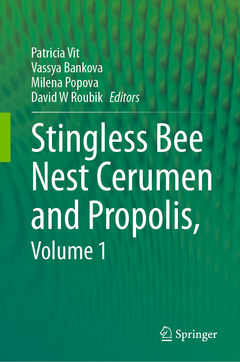Description
Stingless Bee Nest Cerumen and Propolis, Volume 1, 1st ed. 2024
Coordinators: Vit Patricia, Bankova Vassya, Popova Milena, Roubik David W
Language: English
Subjects for Stingless Bee Nest Cerumen and Propolis, Volume 1:
Keywords
549 p. · 15.5x23.5 cm · Hardback
Description
/li>Contents
/li>Biography
/li>Comment
/li>
Meliponini, the stingless bees of the tropics, process and store honey, pollen and plant resins to maintain their colonies. The chemical components of their nests are bioactive and believed to be therapeutic for a long list of maladies. However, only recently are tests and analyses being done with molecular and modern laboratory techniques, such as high throughput EDX, HPIC, HPLC, GC, NMR, PCR, and ultrastructural SEM; coupled with diverse detectors such as DAD, RI, MS, SCD.
This two-volume book is about the cerumen ?plant resins mixed with stingless bee wax? and propolis, which fortify the colony in ways that are beginning to be understood. It includes reviews and new research on diverse topics involving the chemistry and bioactivity of plant resins, cerumen, propolis, besides bee and microbe behavior and ecology. These analytic studies are presented along with stingless bee biodiversity, palynology, cultural knowledge, bee foraging behavior, resin flower evolution, ecology, and evolution of nest microbe mutualisms, social immunity, human health, the decisive role of microbiology investigation in moving forward, natural history of stingless bee colonies and nests, marketing, and bibliometrics for plant resin use by bees, propolis, and the Starmerella yeast.
Patricia Vit has studied Biology and MSc Food Science at Universidad Simon Bolivar, Caracas, Venezuela. She became Professor at Universidad de Los Andes in 1985, completed her PhD at Cardiff University, UK, visited the National University of Singapore, The University of Sydney, Australia, and Universidad Técnica de Machala, Ecuador. She supports the initiative Living Museum of Meliponini Bees in the World. Her research on pot-honey and SBH standards, expanded to cerumen and propolis structures of the nest. More than 100 papers and 34 books were published as an author or editor, including Pot-honey and Pot-Pollen. She received the Award Women in Science 2023, Health Science, from ACFIMAN, Caracas, Venezuela, and is a Council Member of the International Bee Research Association, UK.
Vassya Bankova obtained her PhD in Natural Product Chemistry at the Bulgarian Academy of Sciences, Sofia. In 2004 she became full professor at the Institute of Organic Chemistry with Centre of Phytochemistry, Bulgarian Academy of Sciences. In her research she pays special attention to propolis - its chemical composition, plant origin, biological activity and standardization. Her total number of publications is over 220. She is a founding member of the Bulgarian Phytochemical Society. In 2015 she was elected to a corresponding member of the Bulgarian Academy of Sciences, and in 2020 a member of Academia Europea.
Milena Popova obtained her Master's degree in chemistry and physics at Sofia University “Sv. Kliment Oxridski”; completed her PhD in natural product chemistry at the Institute of Organic Chemistry with Centre of Phytochemistry, Bulgarian Academy of Sciences (IOCCP-BAS) in 2004, and became full professor at IOCCP-BAS in 2019. She was a postdoctoral researcher at University of Athens. Her research interests include chemical profiling, isolation and structural elucidation of bioactive compounds from natural products: endemic plants, propolis, mushrooms. She is a co-auth
Rationale for stingless bee conservation
Ancient cerumen pots and propolis
Natural history and chemistry of stingless bee nest materials




